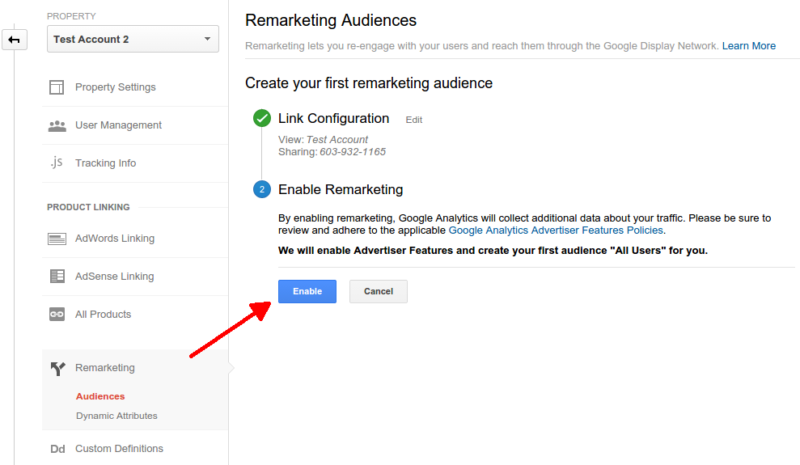The Advantages of Using Remarketing In Google Analytics
Maximize Your ROI With Remarketing in Google Analytics
In the world of electronic marketing, the use of remarketing approaches within Google Analytics has shown to be a potent tool for enhancing return on financial investment. By using the power of customer information and customizing advertisements to certain audience segments, businesses can substantially magnify their conversion prices. The genuine vital lies in the art of precision - recognizing user actions, crafting engaging ads, and constantly refining methods to drive optimal results. The journey to maximizing ROI through remarketing is a nuanced path led with insights and opportunities that can improve the trajectory of your advertising endeavors.
Understanding Remarketing in Google Analytics
Recognizing remarketing in Google Analytics is important for optimizing your electronic marketing strategy. Remarketing enables you to target users who have formerly visited your web site or interacted with your app, offering them with tailored advertisements as they browse other websites or utilize various other applications within the Google Show Network. This technique assists keep your brand top of mind and motivates individuals to return to your site, eventually increasing the possibility of conversion.
By making use of Google Analytics, you can track the performance of your remarketing projects, gaining valuable insights right into customer behavior, engagement, and conversions. This data enables you to improve your messaging, targeting, and bidding strategies to boost the general effectiveness of your campaigns.
In addition, understanding the different types of remarketing listings offered in Google Analytics, such as basic, dynamic, and comparable audiences, allows you to create tailored and extremely segmented projects customized to specific individual segments. This degree of granularity can dramatically improve the importance and impact of your remarketing initiatives, eventually maximizing your return on investment.
Establishing Remarketing Checklists
To successfully execute remarketing campaigns in Google Analytics, the preliminary step involves creating and setting up remarketing lists targeting specific user sections based upon their communications with your website or app. By establishing remarketing checklists, you can customize your marketing initiatives to get to users that have actually already revealed interest in your solutions or products.
To start, navigate to the Admin section of your Google Analytics account and pick the Building where you wish to create the remarketing list. After that, under the Building column, click on 'Target market Definitions' and choose 'Target markets.' Next, click on the red 'New Target market' switch and select 'Develop New' to define the criteria for your remarketing list.

Crafting Reliable Remarketing Ads

When crafting your advertisements, concentrate on producing attention-grabbing headings and compelling visuals that stand apart to potential customers. Incorporate solid calls-to-action that urge individuals to revisit your website and finish a preferred activity. Use dynamic remarketing to show personalized ads including services or products that individuals have actually previously viewed on your site.
Furthermore, guarantee that your ads are mobile-friendly because a considerable part of net web traffic comes from smart phones. Test various ad variations to identify which messages and layouts drive the finest outcomes. By constantly refining and enhancing your remarketing advertisements based on efficiency information, you can maximize their efficiency and enhance your roi.
Analyzing Remarketing Efficiency

Through Google Analytics, marketing experts can track the performance of their remarketing projects in real-time, allowing them to identify trends, patterns, and locations for enhancement promptly. By examining the information, marketers can figure out which advertisements are executing well, which audience sections are responding favorably, and which networks are driving the most conversions. This degree of granularity makes it possible for online marketers to make data-driven choices to enhance their remarketing advocate much go to my blog better results.
Enhancing ROI With Remarketing
Analyzing remarketing data in Google Analytics enables online marketers to determine opportunities for enhancing return on financial investment (ROI) via tactical changes - What Is “Remarketing” In Google Analytics?. To optimize ROI with remarketing, it is important to recognize the actions of click to find out more your audience. By evaluating user interactions, such as the pages they saw, the items they saw, or the activities they handled your site, you can customize your remarketing projects better
Segmenting your target market based upon their actions enables you to create personalized and targeted advertisements that are most likely to resonate with them. By revealing relevant ads to particular sections of your audience, you can raise the chances of conversion and ultimately enhance your ROI.
In addition, evaluating various ad creatives, messaging, and deals can assist determine what reverberates finest with your audience. A/B screening allows you to explore various elements of your advertisements to identify what drives the highest possible interaction and conversion rates.
Verdict
In verdict, taking full advantage of ROI with remarketing in Google Analytics needs a tactical method to examining user habits, segmenting audiences, developing customized ads, and optimizing project performance. By leveraging data-driven insights and examining various methods, companies can enhance their remarketing initiatives to drive higher involvement and conversion prices. This systematic approach ensures that sources are effectively assigned in the direction of making best use of rois in remarketing campaigns.
Next off, click on the red 'New Target market' button and choose 'Create New' to specify the parameters for your remarketing checklist.
By constantly refining and maximizing your remarketing ads based on efficiency data, you can optimize their effectiveness and boost your return on investment.
By diving into these understandings, marketing professionals can acquire a thorough understanding of exactly how their remarketing efforts are reverberating with their target audience and driving conversions. To make best use of ROI with article remarketing, it is critical to comprehend the actions of your audience.In final thought, maximizing ROI with remarketing in Google Analytics needs a critical method to examining user habits, segmenting target markets, creating tailored advertisements, and optimizing campaign performance.